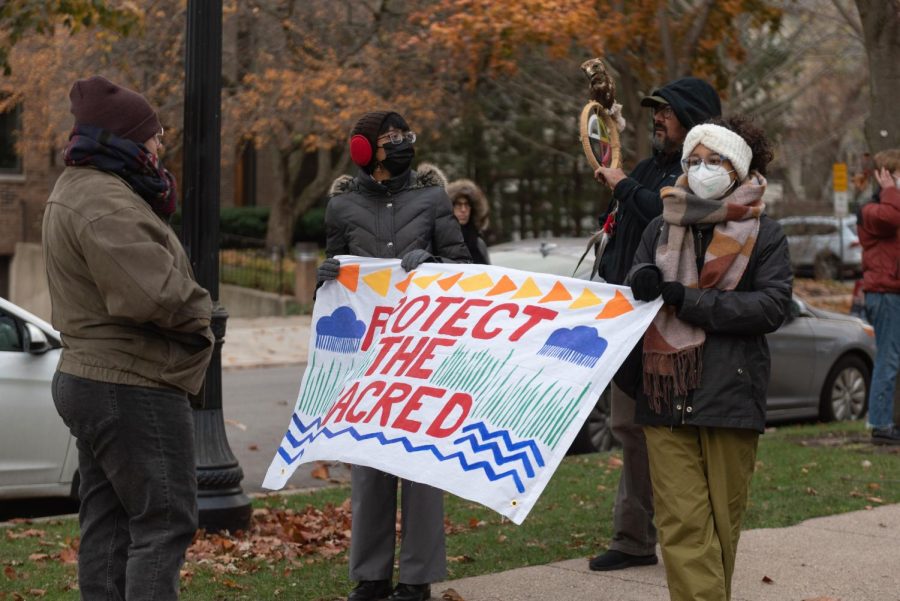30 Days of Indigenous programming celebrates Native American and Indigenous heritage
Esther Lim/The Daily Northwestern
Two people hold a sign reading “Protect the Sacred” prior to walking in a procession for the Sand Creek Massacre commemoration, starting at the John Evans Alumni Center.
November 21, 2022
Content warning: This story contains mentions of death and anti-Indigenous violence.
The sound of drums, singing and the jingle of dancers’ bells filled Norris University Center’s ground floor Nov. 10.
A purple decal of a land acknowledgment spanned some of the windows. Food from Ketapanen Kitchen, a Menominee catering service, included a spread with cloves of garlic and sweet potatoes, bison, squash and wild rice with berries.
The Northwestern Dining food tasting event, which also featured drum and dance performances, was part of a larger series of programming called “30 Days of Indigenous,” organized by Multicultural Student Affairs, the Center for Native American and Indigenous Research and the Office of Institutional Diversity and Inclusion in observance of Native American and Indigenous Heritage Month.
“I could taste the maple syrup in there. It was just a mouthful of flavor,” said Director for Native American and Indigenous Affairs Jasmine Gurneau. “I loved seeing that. It was hitting all of the senses — the taste and the smell and the sounds and the sights.”
This month’s programming centers on being a good relative, which Gurneau, who is enrolled with the Oneida Nation and a descendant of the Menominee Nation, said shows Native American and Indigenous communities’ layers of complexity. Gurneau said she hopes the programming conveys the many facets of Indigenous life and history, because there are more than 570 tribes within the U.S., each with its own customs, languages and constitutions.
Gurneau said the Haudenosaunee peoples, which includes the Oneida, remember the seven generations before and the seven generations that will come after. She said it’s also important to be respectful of non-human relatives, such as place, land and waters.
“This month is really important for me, especially not being home this year or last year,” said SESP sophomore Athena GoingSnake, who is Muscogee Creek and a citizen of the Cherokee Nation. “Being a good relative means respecting and taking care of others around you, listening to people and your environment and going by what your elders say.”
MSA and the Office of Institutional Diversity and Inclusion, in collaboration with the Native American and Indigenous Student Alliance, also held a commemoration of the Sand Creek Massacre on Thursday.
During the 1864 mass murder, the U.S. Army killed about 230 Cheyenne and Arapaho people. In observance, 158 years later, attendees walked in a procession and heard from Indigenous students and community members.
“It’s a hard topic to talk about, but it’s necessary to bring people in to have these difficult conversations,” NAISA co-chair GoingSnake said. “I loved the procession afterward, drinking hot chocolate and getting to talk to people in my community. It was restoring — something I needed.”
Northwestern co-founder John Evans was involved in the Sand Creek Massacre, according to a report from the University of Denver. In its own report from 2014, NU said Evans had no advance knowledge of it.
On Thursday, the Colorado Geographic Naming Advisory Board voted unanimously to rename Mount Evans to Mount Blue Sky. The change will be finalized after it is approved by the Colorado governor and the U.S. Board on Geographic Names.
“It’s incredible and a step in the right direction, recognizing what has happened in the past and finding restorative ways to move past it and for everyone to heal,” said SESP sophomore and NAISA Treasurer Alivia Britton, who is Odawa.
GoingSnake said the name change is an important step in increasing sovereignty rights and the visibility of Native people. Britton said in schools, Indigenous people are talked about as if they only exist in the past.
GoingSnake and Britton said it’s crucial for the University to issue a formal acknowledgement of Evans’ role in the Sand Creek Massacre and apologize for its previous report.
“Northwestern tends to hide from its history, and I think now especially is the time to just step up in this moment and to stop being a coward,” Britton said.
Clarification: This article has been updated to clarify that the Nov. 10 food tasting event was hosted by Northwestern Dining. This story was included in the Nov 21, 2022, paper as “Students celebrate Indigenous heritage.”
Email: [email protected]
Related Stories:
— NAISA commemorates 158th anniversary of the Sand Creek Massacre, reiterates demands to NU
— NAISA celebrates Indigenous Peoples Day with sunrise and sunset gatherings












